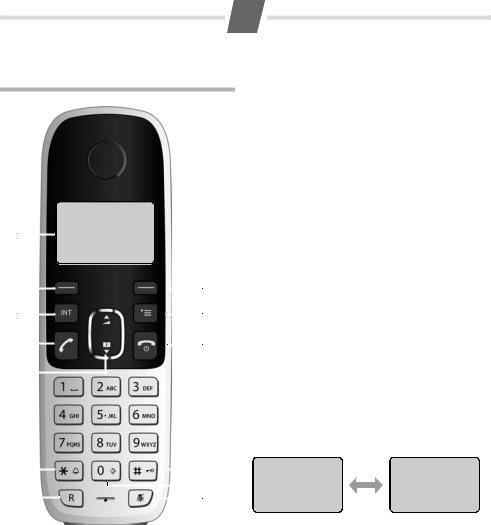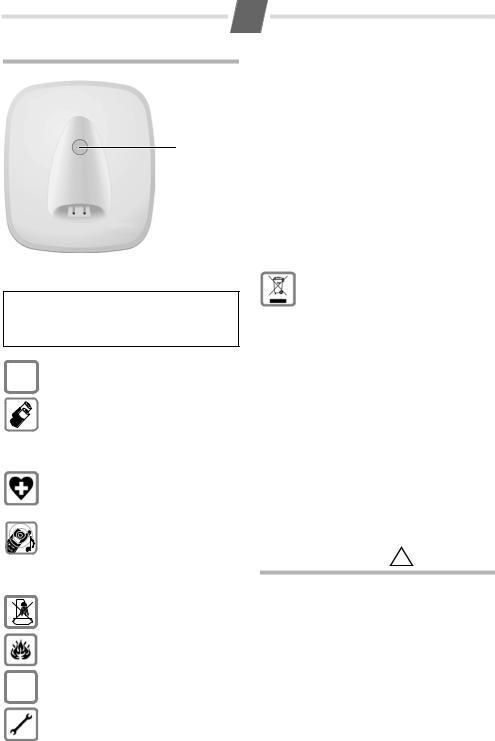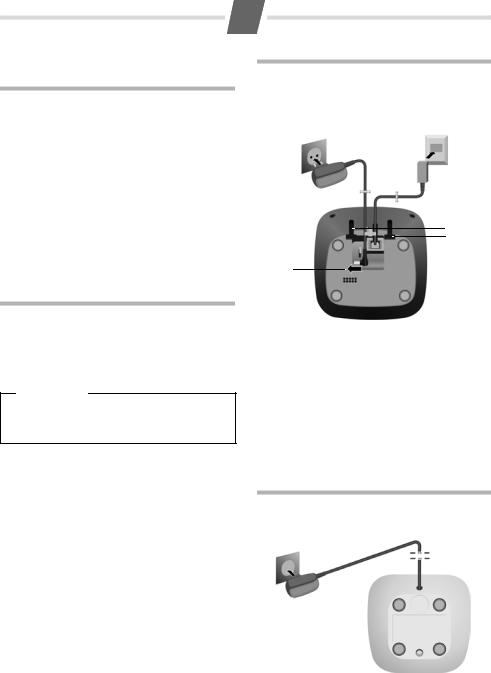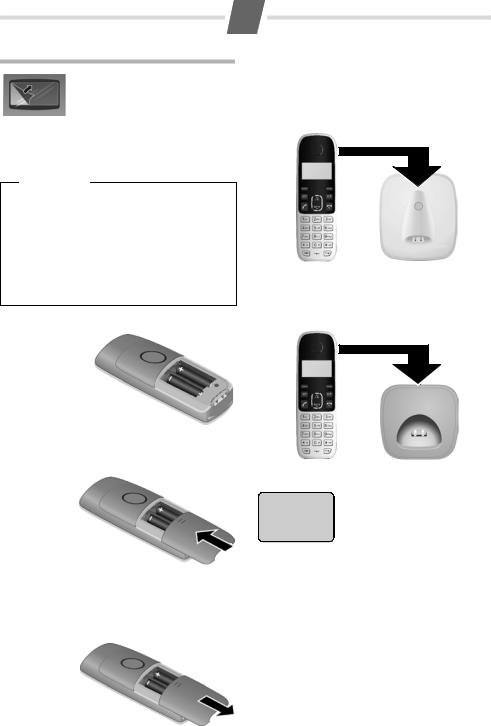Siemens GIGASET A180, GIGASET A180 DUO Operating Manual

1
Gigaset A180/A180 DUO
The handset at a glance
ÒU
1 |
|
|
|
Gigaset |
1 |
|
|
|
|
|
|
|
|
|
|||||
2 |
|
|
|
|
|
|
8 |
||
|
|
|
|
||||||
3 |
|
|
|
|
|
|
|
9 |
|
|
|
|
|
|
|||||
4 |
|
|
|
|
|
|
|
|
10 |
|
|
|
|
|
|
|
|||
|
|
|
|
||||||
5 |
|
|
|
|
|
|
|
|
|
|
|
|
|
|
|
|
|
|
|
|
|
|
|
|
|
|
|
|
|
6 |
|
|
|
|
|
|
11 |
||
7 |
|
|
|
12 |
|||||
|
|
||||||||
|
|
|
|
|
|
|
|
13 |
|
|
|
||||||||
|
|
|
|
||||||
Display icons
ÒRadio signal
Steady: |
Handset is linked with base |
UFlashing: Handset is out of range or not registered
Battery icon
|
Steady: |
Full, more than1 hour talking time |
|
Flashing: |
Charging |
= |
Steady: |
Less than 1 hour talking time |
¼ |
Flashing: |
Almost flat |
Alarm clock is activated |
||
Ú Ringer is deactivated
Ø Keypad lock is activated
1 |
Display in idle mode |
2 |
Back key |
|
When editing text: backspace |
|
In menu: go back to previous level |
3 |
Internal communication key (¢page 13) |
4 |
Talk key / Redial list* (¢page 10) |
5 |
Control key |
|
In idle mode: s open phone book, t open calls |
|
list. |
|
In menu, phone book and lists: Scrolling up/down |
6 |
Star key / Ringer on/off * |
7Recall key Consultation call (flash) Insert pause*
8 |
OK key |
9 |
Menu key (¢page 7) |
10 |
End call key / Power on/off * |
11 |
Hash (#) key / Keypad lock on/off * (¢page 7) |
12 |
Call-by-call key * (¢page 9) |
13 |
Mute key (microphone off) (¢page 9) |
* To activate a function marked with an asterisk (*) press and hold the corresponding key.
Display in idle mode A
¤ Press and hold the key to toggle between
name/number and date/time display. |
|
||||||
Ò |
U |
|
|
|
|
Ò |
U |
Gigaset |
1 |
|
|
|
|
10/31 |
12-30 |
|
|
|
|
||||
|
|
|
|
||||
ªTalk icon
|
Steady: |
Ongoing call |
|
Flashing: |
Incoming call received |
¶ Phone book is opened |
||
Y Calls list icon |
||
|
Steady: |
Already inspected calls in calls list |
|
Flashing: |
New calls in calls list |
|
Off: |
No entry in calls list |
{ |
In editing mode: Backspace. Press A to delete one |
|
|
character at a time |
|
|
In menu: Press A to go back to previous level or exit |
|
| |
menu. |
|
Confirm menu function or save entry with B. |
||
V |
In menu and lists: Scroll up/down with p. |
|
W |
In talk mode: Adjust volume with p. |
|
|
||

2
The base at a glance
Registration/paging key: ¢
Search for handsets: (press briefly, "Paging"¢ page 12)
Register handsets: (press and hold page 12).
Please note: Depending on the device variant the housing may vary in colour.
Safety precautions
Read this user guide and the safety precautions carefully before use. Explain their contents and the potential hazards associated with using the telephone to your children.
$ |
Only use the mains unit supplied. |
|
Fit only the¢recommended, rechargeable batteries ( page 16), i.e. never use a conventional (non-rechargeable) battery or other battery types as this could result in significant health risks and personal injury.
The operation of medical appliances may be affected. Be aware of the technical conditions in your particular environment, e.g. doctor's surgery.
Do not hold the rear of the handset to your ear when it is ringing. Otherwise you risk serious and permanent damage to your hearing.
The handset may cause an unpleasant humming noise in hearing aids.
Do not install the phone in a bathroom or shower room. The handset and base station are not splashproof.
Do not use your phone in environments with a potential explosion hazard, e.g. paint shops.
ƒmake sure you also give them the user guide.
Please remove faulty base stations from use or have them repaired by our service,
as they could interfere with other wireless services.If you give your Gigaset to someone else,
Disposal
All electrical and electronic products should be disposed of separately from the municipal waste stream via designated collection facilities appointed by the government or the local authorities. The correct disposal and separate collection of your old appliance will help prevent potential negative consequences for the environment and human health. It is a precondition for reuse and recycling of used electrical and electronic equipment. For more detailed information about disposal of your old appliance, please contact your local council refuse centre or the original supplier of the product.
Care
Wipe down the base station and handset with a damp cloth (no solvents) or an antistatic cloth. Never use a dry cloth. This can cause static.
Contact with liquid !
If the handset should come into contact with liquid:
Switch the handset off and remove the batteries immediately.
Allow the liquid to drain from the handset.
Pat all parts dry, then with the battery compartment open and the keypad facing down place the handset in a dry, warm place for at least 72 hours (not in a microwave, oven etc.).
Do not switch on the handset again until it is completely dry.
When it has fully dried out, you will normally be able to use it again.

Contents
Gigaset A180/A180 DUO . . . . . . . . . . 1
The handset at a glance . . . . . . . . . . . . . . . . . 1 The base at a glance . . . . . . . . . . . . . . . . . . . . 2
Safety precautions . . . . . . . . . . . . . . . . 2 Care . . . . . . . . . . . . . . . . . . . . . . . . . . . . . . 2
Contact with liquid . . . . . . . . . . . . . . . . . . . . . |
2 |
First steps . . . . . . . . . . . . . . . . . . . . . . . . |
4 |
Check the pack contents . . . . . . . . . . . . . . . . 4 Setting up the base station and
charging cradle . . . . . . . . . . . . . . . . . . . . . . . . . 4 Connecting the base station . . . . . . . . . . . . 4 Connecting the charging cradle . . . . . . . . . 4 Setting up the handset for use . . . . . . . . . . 5 Setting the date and time . . . . . . . . . . . . . . . 6
Using the phone . . . . . . . . . . . . . . . . . . 7
Control key . . . . . . . . . . . . . . . . . . . . . . . . . . . . . 7 Entering numbers and text . . . . . . . . . . . . . . 7 Scrolling to display long numbers . . . . . . . 7 Activating/deactivating the keypad lock . 7 Activating/deactivating handset . . . . . . . . 7 Reverting handset to idle mode . . . . . . . . . 7 Activating/deactivating ringer tone . . . . . 7 Using the menu . . . . . . . . . . . . . . . . . . . . . . . . . 7
Menu tree . . . . . . . . . . . . . . . . . . . . . . . . 8
Making external calls . . . . . . . . . . . . . 9
Making an external call . . . . . . . . . . . . . . . . . . 9 Accepting a call . . . . . . . . . . . . . . . . . . . . . . . . . 9 Ending a call . . . . . . . . . . . . . . . . . . . . . . . . . . . . 9 Adjusting talking volume . . . . . . . . . . . . . . . 9 Muting . . . . . . . . . . . . . . . . . . . . . . . . . . . . . . . . . 9 Call waiting . . . . . . . . . . . . . . . . . . . . . . . . . . . . . 9 Using shortcut keys for speed dialling . . . 9 Call-by-call dialling . . . . . . . . . . . . . . . . . . . . . . 9
Calls list . . . . . . . . . . . . . . . . . . . . . . . . . 10 Last number redial list . . . . . . . . . . . 10
Phone book . . . . . . . . . . . . . . . . . . . . . 10
Using the phone book . . . . . . . . . . . . . . . . . 11 Storing numbers for speed dialling . . . . . 11 Storing call-by-call numbers . . . . . . . . . . . . 11 Deleting the complete phone book . . . . 12
3
Using several handsets . . . . . . . . . . . 12
Registering handsets . . . . . . . . . . . . . . . . . . 12 Deregistering handsets . . . . . . . . . . . . . . . . 12 Locating a handset ("paging") . . . . . . . . . . 12
Making internal calls . . . . . . . . . . . . . 13
Calling another internal participant . . . . 13 Accepting internal call . . . . . . . . . . . . . . . . . 13 Incoming call during internal call . . . . . . . 13 Internal consultation calls . . . . . . . . . . . . . . 13 Transferring a call to another handset . . 13 Conference call . . . . . . . . . . . . . . . . . . . . . . . . 13
Settings . . . . . . . . . . . . . . . . . . . . . . . . . 13
Personal settings . . . . . . . . . . . . . . . . . . . . . . 13 Setting the key beep . . . . . . . . . . . . . . . . . . . 14 Setting date, time and alarm clock . . . . . . 14 Changing the PIN . . . . . . . . . . . . . . . . . . . . . . 14 Restoring to the factory settings . . . . . . . 14
Connecting to PABX . . . . . . . . . . . . . . 15
Prefix setup . . . . . . . . . . . . . . . . . . . . . . . . . . . . 15 Setting flash time . . . . . . . . . . . . . . . . . . . . . . 15 Changing the dialling mode . . . . . . . . . . . 15
Appendix . . . . . . . . . . . . . . . . . . . . . . . . 15
Writing and editing text . . . . . . . . . . . . . . . . 15 Questions and answers . . . . . . . . . . . . . . . . 15 General Specifications . . . . . . . . . . . . . . . . . 16 Recommended batteries . . . . . . . . . . . . . . . 16 Service (Customer Care) . . . . . . . . . . . . . . . . 16

4
First steps
Check the pack contents
one Gigaset A180 base station
one mains adapter for base station
one Gigaset A18H handset (Gigaset A180)
two Gigaset A18H handsets (Gigaset A180 DUO)
one phone cord
two batteries
one battery cover
one user guide
If you have purchased a model with two handsets
(Gigaset A180 DUO), the package additionally contains two batteries, one battery cover and one charging cradle with power adapter for the second handset.
Setting up the base station and charging cradle
The base station and charging cradle are designed for use in enclosed dry rooms with a temperature range
¤Set up the base station at a central location on a flat, non-slip surface in your house or apartment.of +5 °C to +45 °C.
Please note
Pay attention to the range of the base station. This is up to 300 m in unobstructed outdoor areas and up to 50 m inside buildings.
The phone's feet do not usually leave any marks on surfaces. However, due to the multitude of different varnishes and polishes used on today's furnishings, the occurrence of marks on the surfaces cannot be completely ruled out.
Please note:
Never expose the telephone to heat sources, direct sunlight or other electrical appliances.
Protect your Gigaset from moisture, dust, corrosive liquids and vapours.
Connecting the base station
¤Connect the plug from the power supply 1.
¤Plug the power adapter into the plug socket 2.
¤Then connect the telephone jack 3and insert the cables into the cable ducts.
3
2
4
1
¤To mount the base to a wall, fix two screws on the wall and insert the screws into the slots 4.
Please note:
The mains adapter should always be connected, as the phone will not operate without mains connection.
Only use the mains adapter and phone cord supplied.
Pin connections on telephone cables can vary. If you buy a replacement phone cord, make sure that the phone jack has the correct type of wiring.
Connecting the charging cradle
Only for Gigaset A180 DUO
¤ Plug the mains adapter into the plug socket.

Setting up the handset for use
The display is protected by a plastic film.
¤ Remove the protective film!
Inserting the batteries and closing the battery cover
Warning
Use only the rechargeable batteries recommended¢ by Gigaset Communications GmbH ( page 16). Never use a conventional (non-
rechargeable) battery or other battery types as this could result in significant health risks and personal injury. For example, the batteries could explode. The phone could also malfunction or be damaged as a result of using batteries that are not of the recommended type.
Inserting the |
batteries |
¤ Insert the batter- |
|
ies the right way |
|
round. |
|
The polarity is indicated in/on the battery compartment.
¤Slide the battery cover from bottom up onto the casing
until it clicks
into place.Closing the battery cover
Opening the battery cover
If you need to open the battery cover, for instance to
replace the batteries:
¤
5
Placing the handset in the base and charging the batteries
Before you can use the handset, you must first charge
¤Place the handset with the display facing up in the base station.the batteries.
¤If you have a Gigaset A180 DUO place the second handset with the display facing up in the charging cradle.
The idle screen is displayed. The handset name and the internal handset number are shown. The handset is already registered to the base.
In the case of Gigaset A180 DUO both delivered handsets are registered automatically.
If you want to register further handsets, you have to register¢ each individual handset manually
( page 12).
Handsets are assigned the lowest available internal number (1-4). If four handsets are registered you will have to deregister one handset before you can register another.
